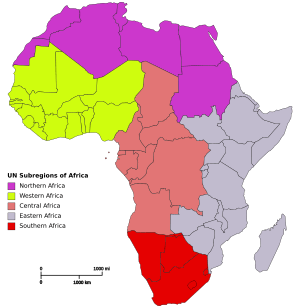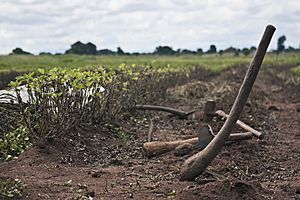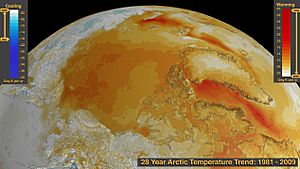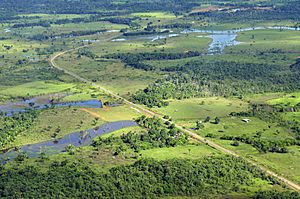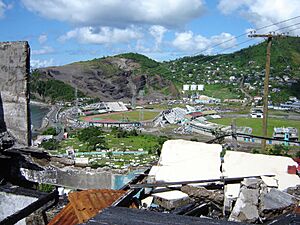Climate change and indigenous peoples facts for kids
Indigenous peoples around the world are facing the biggest challenges from climate change. This means their health, environments, and communities are affected more than others. Many experts believe these greater impacts are connected to historical events and ongoing difficulties. However, indigenous peoples have amazing strategies and traditional knowledge to adapt to climate change. They understand and protect their environments deeply. This knowledge helps their own communities adapt and can also help everyone else.
More than 370 million indigenous peoples live in over 90 countries. Their lands cover about 22% of the planet. These communities are vital guardians of knowledge, especially about how nature and people live together.
Indigenous peoples experience climate change in many ways because they live in diverse places globally. Their cultures and ways of life are often closely linked to the land. These land-based practices are very helpful for slowing down and adapting to climate change, especially if used widely.
Understanding Climate Change Impacts
Millions of people worldwide are moving because of rising seas, floods, droughts, and storms. These changes affect indigenous peoples more severely.
Many indigenous farmers have noticed big changes in nature. For thousands of years, they used traditional calendars based on wind, blooming seasons, and bird migrations. Now, global warming is changing these patterns. Farmers who rely on traditional methods find it hard to predict weather. They often lack access to modern technology and weather forecasts.
These changes create stress for indigenous communities. Farming practices that worked for centuries are becoming difficult. This affects people's well-being, especially when farming is linked to their culture and beliefs.
Indigenous peoples are more affected by climate change for several reasons:
- They often live in areas most vulnerable to climate change. These include rainforests, the Arctic, and coastal regions.
- Their cultures and ways of life are deeply connected to the environment. Changes to nature affect their physical and spiritual health.
- Historical challenges and poverty have made them more vulnerable. These include past difficulties and economic disadvantages.
- Many indigenous communities face economic challenges. These include less access to education and higher rates of unemployment. These issues make it harder to adapt to climate change.
Despite these challenges, indigenous peoples are very good at adapting to environmental changes. Their adaptability comes from their traditional knowledge. However, some of this knowledge has been lost due to past hardships. Losing this knowledge and facing ongoing difficulties can be a bigger threat than climate change itself.
The United Nations Declaration on the Rights of Indigenous People recognizes the special knowledge and practices of indigenous peoples. These can help manage natural resources in a sustainable way.
Indigenous Climate Action and Leadership
Indigenous peoples are actively fighting climate change through various efforts, including climate activism. Here are some inspiring examples:
Young Indigenous Climate Activists
- Autumn Peltier from Wiikwemkoong First Nation in northern Ontario, Canada, is a powerful voice for water protection. She became the chief water commissioner for the Anishinabek Nation in 2019, at just 14 years old. Autumn works hard to protect indigenous waters and is a key part of the climate action movement.
- Nina Gualinga from the Kichwa-speaking community of Sarayaku in the Ecuadorian Amazon, has dedicated her life to protecting nature. At 18, she helped win an important case against the Ecuadorian government for allowing oil drilling on indigenous lands. Nina now speaks globally for indigenous rights and a future without fossil fuels. She received the World Wide Fund for Nature (WWF) International President's Youth Award for her conservation work.
Community-Led Solutions
Indigenous communities are also creating their own solutions. For example, Canadian Inuit people in Rigolet, Nunatsiavut, Canada, are teaching traditional skills. This helps people feel more connected to their culture and each other. They also worked with the University of Guelph to create an app. This app lets community members share information about sea ice safety, reducing worries about environmental changes. These tools help them cope with the sadness they feel about changes to their environment.
Working with Governments
Indigenous groups are partnering with government programs to adapt to climate change. The Climate Change and Health Adaptation Program (CCHAP) in Canada is one example.
- The Selkirk First Nation in Yukon worked with CCHAP on a project. It focused on how land, water, and people are connected. This project helped maintain cultural practices and food security, supporting their well-being.
- The Mi'kmaw Conservation Group in Nova Scotia also partnered with CCHAP. They researched climate change, involved community members, and developed emergency plans.
- The Indigenous Climate Action (ICA) is Canada's only indigenous climate justice organization. They provide education and tools to use indigenous knowledge for climate solutions. For instance, they organized protests that helped stop the Frontier Tar Sands Project.
How Indigenous Knowledge Helps
Historically, indigenous peoples were often left out of climate change discussions. For example, in 2005, indigenous people in the Ecuadorian rainforest were not included in a project to reduce deforestation. This was despite their lands suffering from less biodiversity and more greenhouse gases. Including indigenous voices in these talks offers valuable solutions.
The Power of Traditional Knowledge
Many believe that indigenous people are better at protecting their forests than national parks. This local knowledge, called indigenous knowledge (IK), helps understand climate change impacts. It is especially useful at the local level where scientific models sometimes fall short. Environmental programs work better when indigenous peoples help shape them.
A special part of IK is traditional ecological knowledge (TEK). This knowledge is passed down through generations. It describes how indigenous groups relate to living things and their environment. TEK helps promote sustainable use of resources.
Indigenous connections to land are key to sustainability. For example, the Iñupiat communities in Alaska have spiritual ties to whales. This connection gives them deep insights into environmental changes. Climate change threatens whale migration and numbers, which affects Iñupiat identity. They are adapting to these changes.
Combining indigenous knowledge with modern science creates strong, local plans for sustainability. It can also give scientists new information that is hard to find otherwise. For instance, TEK from the Andean Mountains helped scientists predict El Niño events. This shows how traditional knowledge and modern science can work together against climate change.
An example of indigenous knowledge for wider sustainability is kelp farming in Cordova, Alaska. The native Eyak people sustainably use seaweed. This practice can grow because kelp helps sequester carbon, fights ocean acidification, and can be an alternative to plastics. It also supports indigenous independence by creating a new industry led by native peoples.
Indigenous Governance and Global Goals
Including indigenous knowledge in climate governance can lead to better food security. It also encourages shared responsibility for natural resources, aligning with sustainable development and the UN's Sustainable Development Goals. When indigenous people, who are most affected by climate change, are involved in decisions, it builds stronger communities. This local sustainability then helps at higher levels. Using indigenous knowledge at the local level is seen as the most effective way to achieve global sustainability.
Indigenous communities in Northern Australia have traditional knowledge about weather patterns. They have adapted to climate change for thousands of years. This knowledge can help everyone adapt in the future. More scientists and activists now support including TEK in climate change policies.
In 2008, the American Museum of Natural History held a conference. Indigenous leaders, scholars, and scientists discussed the role of indigenous people in fighting climate change.
The Intergovernmental Panel on Climate Change (IPCC) supports including IK. They stated that indigenous knowledge is "critical for adaptation." It helps through diverse farming systems, shared community memory, and social networks. Many experts agree that recognizing indigenous rights and governance is central to adaptation and sustainable development.
Climate Change Impacts by Continent
Africa
Climate change in Africa is causing food shortages, displacement, and more famine, droughts, and floods. Indigenous people in Africa are especially affected. They face limits on moving, suffer more from less biodiversity, and their farmland is degraded by climate change.
West Africa
In Nigeria, the Niger Delta is very vulnerable to climate change. Flooding happens yearly, displacing many people. In Benin, indigenous farmers have always adapted to challenges. They change their farming practices, like sowing dates, due to climate shifts. Factors like their economic status and farming techniques help them adjust. This shows the need for specific support, like climate information, for these communities.
Droughts, floods, and drying water sources in West Africa have increased conflicts between farmers and herders. The Fulani people use their traditional knowledge for climate adaptation. They diversify livestock feed, manage cattle stress, and divide labor. Shifting from herding to farming and improving rangelands also helps reduce conflict.
East Africa
East African indigenous communities, like the Tonga in Zambia, deeply understand nature. They use selective harvesting, organic farming, and protect sacred water. Their sustainable methods, rooted in traditions, show the strong link between humans and nature. In Malawi, indigenous techniques like planting maize with legumes improve soil and drought resistance. Agroforestry, planting trees with crops, provides shade and moisture.
The Boorana people use animal behaviors and celestial patterns to predict weather and droughts. Their systems have proven reliable. Their resource management and social support systems help them adapt to drought challenges. Similarly, the Afar community's observations help them understand temperature trends and forecast weather, strengthening their adaptation to climate change.
Northern Africa
In southern Egypt and northern Sudan, indigenous farmers still use the ancient Coptic calendar. However, climate change is making it hard to follow. High temperatures delay planting, affecting the entire crop cycle. According to Ismail El Gizouli, a Sudanese scientist, the calendar was "almost perfect" until 20 years ago. Now, climate change causes yearly variations.
Indigenous communities in North Africa, like the Maasai in Tanzania, face long droughts, food insecurity, and displacement. Their nomadic pastoralism is threatened by lost grazing lands and water. Despite their sustainable practices, they are often excluded from decisions. Efforts to address climate change must recognize indigenous rights and include their knowledge.
Southern Africa
Southern Africa is a subtropical region. Drought is a major threat from climate change, affecting farming and livelihoods. Pastoralists have adapted by moving their livestock to find water. A study in Thaba 'Nchu, South Africa, found that some farming households are more vulnerable to water shortages. Understanding these differences helps us see how climate change affects indigenous ways of life.
Arctic
The Arctic region is experiencing the most dramatic impacts of climate change. Temperatures are rising twice as fast here than anywhere else. This creates huge challenges for indigenous nations in the region. While these nations live in Arctic countries, most emissions come from oil and gas companies, not indigenous communities. Organizations like the Native Movement highlight this unfairness, arguing that responsible countries and corporations should help with the damages.
The increase in global carbon dioxide emissions is causing significant arctic sea ice decline. This not only affects global temperatures but also harms indigenous nations in unique ways. Indigenous peoples in the Arctic live in Canada, Greenland, the United States, Norway, and Russia.
In Canada, there are nine main Inuit groups and other non-Inuit nations like the Cree. In Greenland, most people are Inuit. In Alaska, US, Arctic indigenous peoples include Yup'ik, Iñupiat, and Athabascan peoples. The Sámi people live in Norway, Finland, Sweden, and Russia, and are the only indigenous group in the European Union. Russia is home to over 180 indigenous peoples, including the Buryats and Nenets. Iceland is the only Arctic country without indigenous nations. All these groups face risks from melting ice, rising sea level, increased erosion, and loss of traditional food sources due to climate change.
For the Sámi people, their relationship with reindeer is at risk. Reindeer herding has sustained them for centuries. Climate change is altering snow conditions and temperatures in areas like Finnmark, Norway. Traditionally, Sámi herders moved to better areas. However, modern barriers like economic rules, habitat loss, and less snow make this harder. Reindeer are vital to Sámi culture, inspiring their language and stories. Scandinavian countries and the world must recognize Sámi traditional knowledge and their right to be part of decision-making.
Asia
Indigenous people in Asia face many problems from climate change. These include long droughts, floods, irregular seasons, strong typhoons, and unpredictable weather. This leads to less food and water, and more water-borne diseases, heat strokes, and malnutrition. Their traditional ways of life are disrupted. Also, the expansion of large farms, hydroelectric dams, and uranium mining on their lands, often without their consent, adds to their challenges.
In South Asia, climate disasters like floods and droughts cause food insecurity, displacement, and health crises for indigenous communities. This region is vulnerable due to its large population, poverty, and major river systems. Indigenous people, who rely on agriculture, face threats to their food supply from changing weather and reduced crop yields. Extreme weather also displaces people and strains healthcare. Governments' slow response worsens these impacts.
Many indigenous communities in China also adapt to climate change using traditional knowledge and farming methods. Their knowledge, suited to diverse climates, helps them adapt. However, their methods often receive little recognition from Western scientists.
In India, indigenous communities use their deep understanding of the environment to combat climate instability. The Lepcha community uses traditional agroforestry to control temperature and mulch to save soil moisture. This helps them deal with dry conditions. The Lachenpas and Dokpas communities predict seasons using local species. For example, bird migration helps them detect monsoon changes, which is vital for their survival.
In southern Iraq, indigenous farmers still follow ancient agricultural methods. But global warming has affected crop cycles due to longer, hotter summers. Fruits are not appearing at their usual times. High temperatures also make it hard to move buffalos from water, causing stress. Older indigenous farmers are confused by the changing climate and unsure when and what to plant.
North America
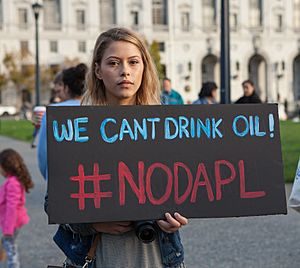
Climate change in North America brings rising temperatures, changing rainfall, less glacier and snow cover, and more floods, droughts, and extreme weather. This can lead to food and water shortages, less access to traditional foods, and more infectious diseases.
One in four Native Americans face food insecurity. North American peoples, like the Inuit, rely on hunting, fishing, and gathering. Traditional foods make up a significant part of their diet. These activities are crucial for their culture and self-determination. Their diets include foods like wild rice, shellfish, beans, moose, deer, berries, caribou, and fish. Climate change affects freshwater quality, animal migration, and plant availability. This makes it harder for tribes to eat traditional diets and practice cultural activities. Without these essential foods, and often living in "food deserts" with poverty, Native Americans on reservations face higher rates of diseases like diabetes and obesity.
Indigenous populations in the United States and Canada are very vulnerable to climate change due to economic disadvantages. These changes affect groups like Alaska Natives, Inuit, and Gwichʼin people. Indigenous communities often have higher rates of poverty and less access to education, housing, and jobs. These conditions increase their vulnerability and limit their ability to recover from climate change impacts. Indigenous farming practices, based on ancient wisdom, are struggling as climate change disrupts seasons. For example, Hopi tribesmen in Arizona, who relied on natural signs, now face unpredictable conditions. This threatens their farming and cultural ties to the land.
Some proposed solutions for climate change, like certain pollution controls or genetically modified organism (GMO) foods, can sometimes go against indigenous rights. Many tribal communities need to relocate or protect against rising sea levels. However, they often lack funds and government support for these efforts. This can further harm indigenous cultures. The loss of biodiversity also limits their ability to adapt. These changes, along with the destruction of important ecosystems, can negatively affect people's mental health and their "sense of place."
Rising temperatures also threaten cultural practices. Many indigenous ceremonies involve fasting for days, which can become dangerous in extreme heat.
Understanding indigenous knowledge is key. This knowledge, built over generations, describes people's relationship with the environment. It is becoming very important in climate change discussions due to its long history of ecological observations. However, sharing this knowledge has risks. Traditional knowledge is often part of an indigenous group's spiritual identity. Misuse can lead to disrespect, so some are hesitant to share. An example of effective use is Alaska Natives monitoring the Arctic. Their knowledge helps track animal behavior and weather patterns, and develop adaptation strategies.
Indigenous activism has risen in response to environmental changes. The #NoDAPL movement saw tribal citizens protest an oil pipeline through indigenous land. In Northwestern Ontario, the Asubpeeschoseewagong First Nation protested clearcutting. Tribes in Washington have protested overfishing. Indigenous environmental activism aims to address their vulnerability and contribute to discussions about tribal sovereignty. Indigenous scientists and organizations, like the American Indian Science and Engineering Society, emphasize including indigenous sciences in sustainability efforts.
Oceania
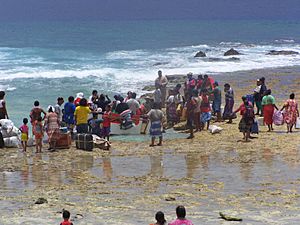
The Pacific region, with its low elevation and coastlines, is very vulnerable to rising sea levels and erosion from climate change. Entire islands have sunk, displacing indigenous people. The region also faces more frequent and severe cyclones, floods, and less biodiversity due to damaged coral reefs. This means fewer fish and other sea life that indigenous people rely on for food. They are also losing food sources like sugarcane and bananas, and have less drinkable water.
Many Pacific island nations depend on tourism. Climate change affects this industry. Warming oceans cause coral bleaching, which harms the reefs that attract tourists, leading to economic decline.
Rebecca Tsosie, an expert in indigenous human rights, notes that climate change impacts are very visible in the Pacific. Indigenous peoples' deep connection to their environment means they need to adapt quickly to these changes.
Australia

Many Aboriginal people live in rural and remote areas across Australia. They face various climate impacts, including cyclones in the north and floods in Central Australia. These events harm cultural sites and the connection between indigenous people and their traditional knowledge.
Changes include rising sea levels, hotter and longer heatwaves, and more severe cyclones. Other issues are wildfires, floods, and erosion. Communities in the North, where Indigenous Australians and Torres Strait Islanders make up 30% of the population, are most affected. These communities are disadvantaged and rely on their traditional lands for food, culture, and health. This raises questions about whether they should move or stay.
Indigenous communities throughout Australia have adaptation strategies. For example, the Lajamanu and Mirriwong communities use regular patch burning. They burn specific areas at certain times to reduce vegetation, which lowers wildfire risk. These burns also help fresh grass and bush food grow, benefiting wildlife. The Mirriwong people also use riparian vegetation to cool water for aquatic life during hot seasons.
Aboriginal Australians have lived on the continent for tens of thousands of years. They have observed and adapted to climate changes for millennia. This unique history positions them to respond to current climate changes. Although their practices have evolved, traditional ecological knowledge (TEK) still exists that can help communities today. However, indigenous people have not had enough opportunities to share their knowledge in international and local climate change policies.
Latin America
Indigenous Peoples' Backgrounds
While some indigenous cultures thrive in cities, most indigenous peoples in Latin America live in rural, poorer areas. This includes countries like Ecuador, Brazil, Peru, and Paraguay. Indigenous people make up 40 million of the Latin American-Caribbean population. This makes them very vulnerable to climate change due to social, geographic, cultural, and political factors. They often have limited formal education. Living mostly in the Amazon rainforest, there are over 600 different indigenous groups, each with unique languages, beliefs, and practices.
Climate Change Impacts on Indigenous Peoples
Human actions like land use and resource extraction have worsened climate change. These actions threaten indigenous peoples' livelihoods in vulnerable areas. Specifically, industries that extract resources in the Amazon are harming indigenous people and making climate change worse. These activities often happen without the consent of indigenous communities. Deforestation not only harms these areas but also releases more carbon into the atmosphere, speeding up climate change. This has a greater impact on indigenous people in Latin American tropical forests, sometimes forcing them to leave their lands.
In the Amazon Basin, where fish are a main food source, changing rainfall and floods greatly affect fish reproduction. This also impacts turtles. Climate change has altered bird migration patterns and changed the start and end of wet and dry seasons, further disrupting daily life for indigenous people.
Climate change also threatens indigenous languages in the Amazon rainforest. About 20% of the world's endangered languages are found here. Losing ancestral lands could prevent these languages from being preserved, leading to a cultural crisis and the loss of ancient knowledge and community identity.
Indigenous peoples often face the most severe impacts of climate change, even though they contribute the least. Their rights and resources are often overlooked. Because of their close connection to nature, they are among the first to experience the devastating effects of climate change.
Women's Role and Adaptation
Indigenous women often face greater challenges from climate change. Discrimination can limit their political involvement. However, countries like Bolivia and Ecuador have seen improvements in indigenous peoples' political participation. Women often do hard physical labor. In Brazil, an organization introduced an eco-stove that reduces the need for heavy fuelwood. This has helped indigenous women live healthier and easier lives.
Indigenous peoples' deep knowledge of weather patterns makes them vital for adapting to climate threats. For hundreds of years, they have developed sustainable cultural strategies. This knowledge is passed down, making them crucial for understanding nature and conserving the environment. In Latin America and the Caribbean, indigenous peoples are changing farming practices to adapt to climate changes. They are also moving agriculture from dry areas to wetter ones. It is important to protect the environment in the Americas, as 65% of indigenous land remains undeveloped.
Policy and Global Action
After the Zapatista movement in Mexico in the mid-1990s, indigenous issues gained international recognition. This led to progress in indigenous political involvement. Bolivia, Ecuador, and Venezuela have strong indigenous political representation. International agreements like the 2030 Agenda for Sustainable Development, the Paris Agreement, and the Addis Ababa Action Agenda now recognize indigenous peoples' rights.
Indigenous women play a crucial role in fighting climate change. It is important to recognize their strong leadership and successes. Despite climate change threats, indigenous women are pushing for sustainable solutions locally and globally.
Caribbean
Climate change impacts indigenous peoples in the Caribbean disproportionately, even though they contribute least to the problem. The main effect of climate change in the Caribbean is more frequent extreme weather events. There have been many flash floods, tsunamis, earthquakes, strong winds, and landslides. These events cause widespread damage to homes and public property. For example, Hurricane Ivan caused damage equal to 135% of Grenada's GDP, setting the country back years.
Indigenous people feel these effects most strongly. They were often forced to live in the most extreme areas due to historical challenges. In these regions, extreme weather is even worse, destroying crops and livestock. People in the Caribbean also report erosion of beaches, less beach access, less vegetation, rising sea levels, and drying rivers. Erosion is partly due to increased building along coastlines for tourism.
In 2005, a large coral bleaching event happened across the Caribbean, likely due to high sea surface temperatures. This harms marine ecosystems and reduces fish stocks, which indigenous Caribbean peoples rely on for food and income. Many regions in the Caribbean also face water shortages, as they depend on rainfall and groundwater.
Indigenous peoples and other inhabitants need to integrate disaster plans and environmental conservation into their daily lives. As indigenous lands are often threatened by governments and industries, it is important for indigenous peoples to partner with groups like the Rainforest Alliance to fight for their rights. The Caribbean region is focusing on helping indigenous peoples use their traditional knowledge to build community resilience to climate change.
See also
 In Spanish: Cambio climático y pueblos indígenas para niños
In Spanish: Cambio climático y pueblos indígenas para niños


